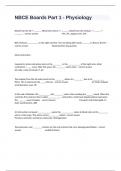NBCE Boards Part 1 - Physiology
Blood from the UE >> ______. Blood from the LE >> ______. Blood from the lumbars >> _____ >>
_______. - correct answer SVC, IVC, azygous vein, SVC
80% of blood __________ to the right ventricle. The remaining 20% needs _______ to flow to the RV. -
correct answer Passively flows (via gravity)
Atrial contraction
Impulse for atrial contraction starts at the ________ in the ___________ of the right atria. Atrial
contraction = ____ wave. After this wave, the ________ valves close. - correct answer
SA node, crista terminalis, P, AV
The impulse from the SA node travels to the ________ where it is ________ due to its __________
fibres. This is represents the ____ interval. - correct answer AV node, delayed,
small diameter axon, PR
At the end of diastole, the __________ and ________ valves close creating the ______ sound. When the
ventricles first contract, this is called ____________ contraction. Ventricular depolarization represents
the _______ wave/complex. - correct answer Tricuspid, mitral (bicuspid), S1
(lub), isovolumetric, QRS
At mid systole, increased ____________ opens the ___________ valves & blood exits via the ________
artery to the lungs. This artery carries _________ blood - correct answer
Pressure, pulmonic semilunar, pulmonary, deoxygenated
The pulmonary and ________ arteries are the only arteries that carry deoxygenated blood. - correct
answer umbilical (fetus)
,Blood becomes oxygenated at the lungs via the _________ effect. Blood exits the lungs via _________
and enters the __________, which has the highest concentration of ____ in the cardiac system. - correct
answer Bohr, pulmonary veins (4), left atrium, O2
The pulmonary and _________ veins are the only veins that carry oxygenated blood. - correct answer
umbilical
80% of blood _________ flows from the LA to the LV via the _______ valve. The other 20% requires the
_____ wave. - correct answer passively, mitral (bicuspid), P
Blood passively, then actively flows from the Left Atrium to the Left Ventricle via the ______ valve. -
correct answer Mitral (bicuspid)
The mitral valve closes, the ventricles contract creating _________ contraction. At mid-systole the
_______ valve opens sending blood to the ________. When the aortic valve closes it creates the ______
sound & an ________ relaxation. - correct answer Isovolumetric, aortic, aorta,
S2 (dub), isovolumetric
P wave of EKG represents __________. _________ contract - correct answer
atrial depolarization, atria
P-R interval of EKG represents ___________ - correct answer AV nodal delay
R spike of EKG represents _________ contraction where the impulse is released from the AV node down
the __________ & into the __________ fibers. - correct answer Isovolumetric
contraction, Bundle of His, Purkinje fibers
Moderator band of Bundle of His - correct answer Muscular band of heart
tissue in the septomarginal recess of the RV, carries the R bundle branch of the AV bundle to the
anterior papillary muscle
The Purkinje system in the ventricles is ____________ faster than AV node and _______ faster than
other neurons in the heart because of _________ & _________. - correct answer
150x, 400x, gap junctions, intercalated discs
,QRS complex of EKG represents ___________ - correct answer Ventricular
depolarization
In an EKG, atrial repolarization is _________ - correct answer Hidden under the
QRS complex
______________ & _______________ muscles prevent backflow post ventricular contraction. - correct
answer Chordate tendinae, papillary muscles
T wave of the EKG represents ___________. - correct answer Ventricular
repolarization
Repolarization of _________ muscles may be present in a _____ wave in the EKG. - correct answer
papillary, U wave
S-T segment of EKG represents ____________, where there is _______mL of blood in the ventricles & all
valves are ________. - correct answer Isovolumetric relaxation, 50, closed
An inverted T wave or altered S-T segment would indicate _________. - correct answer
Myocardial infarction (acute heart failure)
The heart is prevented from tetany via ______ Ca2+ channels that create a long __________ refractory
period - a ________ phase in the cardiac AP. During this period, it is ________ to fire the heart again. -
correct answer slow, absolute, plateau, impossible
The autorhythmicity, aka __________, of the heart is maintained by leaky ____ channels. The heart can
beat on its own at a rate of ~______ BPM. Autorhythmicity occurs at the __________, aka ,the
________. - correct answer automatic conductivity, Na+, 45, SA node,
pacemaker
Primary heart block = elongation of the _________________ which is a physiologic or abnormal
_______________ at the AV node. - correct answer PR interval, progression of
electrical conduction
, Secondary heart block = _____________ phenomenon which is the elongation of PR interval until
___________ occur before the ventricles contract. - correct answer
Winkebock's, 2 atrial depolarizations
More fibers are damaged with _________ heart block. - correct answer
Secondary
Complete/tertiary heart block is seen when there is ______________. - correct answer
No pattern to the EKG (random)
S1 sound. Appears during what? - correct answer Closure of AV valves (tri & bi)
Isometric contraction
S2 sound - correct answer Closure of semilunar valves (aortic & pulmonic)
S3 sound is heard when (2)? - correct answer Passive filling, may hear in child
Ventricular gallop in CHF
S4 sound - correct answer Similar to S3, heard in diastole, atrial gallop
Diastole - correct answer Relaxation, filling
Systole - correct answer Contraction
What is used to detect murmurs? - correct answer Echocardiograms




